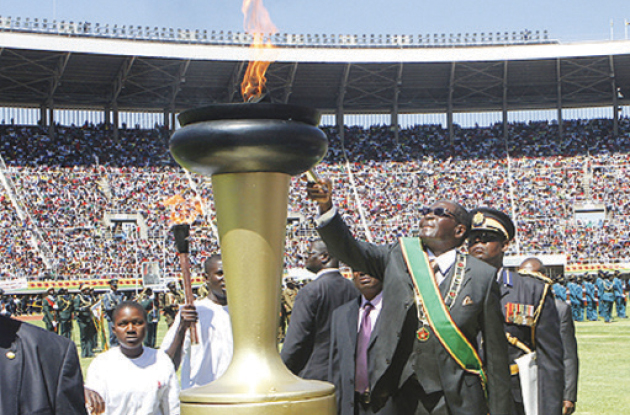The journey from colonial bondage


President Mugabe lights the independence flame during the country’s 33rd independence celebrations in Harare
Cuthbert Mavheko
ON April 18, Zimbabweans from all walks of life will commemorate the country’s 35th independence anniversary.
Independence Day is a time to reflect on where we came from as a nation, where we are today and where we are going. The road to freedom and independence was long, arduous and fraught with peril.
On this march, over 30,000 lives were lost and many sacrifices were made. Pain, suffering, misery and death was the price that Zimbabweans paid on the long pilgrimage from the darkness of colonial enslavement towards the light of freedom and independence.
Prior to independence, the system of government that existed in the country promoted the interests of white people while suppressing indigenous blacks.
Blacks faced a myriad of problems that stemmed from the oppressive colonial laws of the day and racial segregation.
The oppression and exploitation of blacks came in diverse ways. Black workers in all sectors of the economy toiled for peanuts. Resultantly, hordes of them and their huge, extended families lived in conditions of squalor and poverty that defy all common sense and logic.
In 1977, over 90 percent of black workers in Salisbury (now Harare) wallowed in abject poverty. The fall in real wages in the manufacturing industry between 1975 and 1979 sent the already poor living standards of black workers plummeting to very low levels.
The situation on white-owned farms was even worse. Black farm workers were treated almost like garbage. They were over-worked, underpaid and lived in fear of, not only their abusive white employers, but also their children who they were forced to address as “pikinini baas” or “madam.”
The whites owned all the fertile land in the country and blacks were crowded in tribal trust lands, where they eked out a miserable existence on tiny pieces of unproductive land. Throughout Zimbabwe’s history, land has always been the most important political and economic issue and can be traced back to the colonial era.
Cecil John Rhodes’ British South Africa Company (BSAC) seized land owned by indigenous blacks in 1890, driving them from the land and brutally murdering those who resisted eviction. In the early 1900’s a plethora of laws, which legitimised the removal of blacks from their ancestral lands, were passed by the white colonial settlers. One such law was the Land Apportionment Act of 1930, which legalised an apartheid-like system where blacks were separated from whites and dumped into tribal trust lands, which were less fertile, hilly and rocky.
By 1923, the white settlers controlled almost one sixth of all prime fertile land in the country. The shocking paradox is that the whites comprised only three percent of the population and yet they controlled over 75 percent of all fertile land in the country while 97 percent of blacks owned only 23 percent of poor, overcrowded and drought-prone land.
The settlers also seized large herds of cattle from blacks and used them (blacks) as cheap labour on farms they (the whites) had pegged. To add insult to injury, white settlers also demanded hut, dog, cattle and even bicycle tax from locals, thus forcing them to work under a slave-like system called chibharo for them to have money with which to pay the extortionate taxes.
The issue of land was one of the major reasons that ignited the armed struggle. As the collapse of the white settler regime looked imminent, the British government, under the late Margaret Thatcher, pledged (at the Lancaster House Conference held in 1979) to compensate all whites, whose land would be acquired after independence for resettlement under Zimbabwe’s land reform initiatives.
However, when a new Labour Government, led by Tony Blair, came into power in 1997, it reneged on its predecessors’ pledge to fund land reforms in Zimbabwe. Its Overseas Development Minister Clare Short made it clear, at the time, that her government would not compensate former white commercial farmers for land that they gave up.
“I should make it clear that we don’t accept that Britain has a special responsibility to meet the costs of land purchase in Zimbabwe. We’re a new government from diverse backgrounds, without links to former colonial interests,” she said.
This shifting of goal posts by the British finally prompted Zimbabwe’s former freedom fighters and the landless to occupy farms owned by white commercial farmers in 2000. This, in turn, forced the Zimbabwe government to regularise and legitimise land acquisition and redistribution through the Land Acquisition Amendment Act of 2002.
To date, land reforms have benefitted over 300,000 households, including a new class of successful local tobacco farmers. Contrary to falsehoods being peddled by the country’s detractors that the land reform exercise has failed, some Western academics like Professor Ian Scoones, have scientifically analysed Zimbabwe’s land revolution and confirmed its resounding success.
However, it is disquieting to note that some A2 farmers are under-utilising land and viewing it (land) as a status symbol.
Speaking to thousands of people who attended Kutama Mission centenary celebrations in Zvimba recently, President Mugabe castigated the A2 farmers for under-utilising land. He said the government would soon undertake a land audit to see if the land is fully utilised for the benefit of nation or not. The audit is now underway. Those simply sitting on the land would lose it, he warned.
It is my considered opinion that the land audit should not only be limited to ascertaining how those allocated farms are using their land, it should also revisit the distribution of land itself to see if it was done properly.
Reports have surfaced that some 10-year-old Zimbabweans were allocated land when it is only those over 21 years who were supposed to benefit.
This shows that there are some anomalies in the allocation and distribution of land in the country. We have also heard that disgraced former political heavyweights such as Ray Kaukonde and Didymus Mutasa owned many farms and rented some of the farms to white farmers while donating others to their girlfriends.
Land reforms were effected in the country for the benefit of all Zimbabweans. To this extent, those who hold land for speculative purposes should be removed from the land and their land given to those who can fully utilise it.








Comments